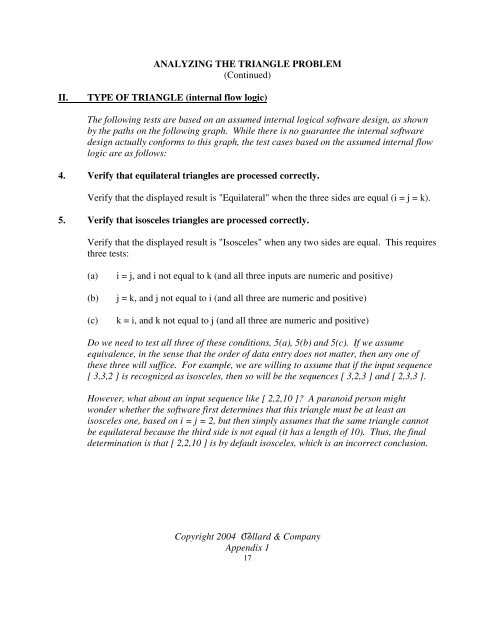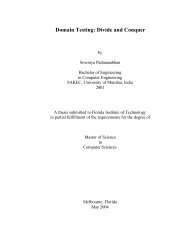appendix 1. analyzing the triangle problem - Testing Education
appendix 1. analyzing the triangle problem - Testing Education
appendix 1. analyzing the triangle problem - Testing Education
You also want an ePaper? Increase the reach of your titles
YUMPU automatically turns print PDFs into web optimized ePapers that Google loves.
ANALYZING THE TRIANGLE PROBLEM<br />
(Continued)<br />
II. TYPE OF TRIANGLE (internal flow logic)<br />
The following tests are based on an assumed internal logical software design, as shown<br />
by <strong>the</strong> paths on <strong>the</strong> following graph. While <strong>the</strong>re is no guarantee <strong>the</strong> internal software<br />
design actually conforms to this graph, <strong>the</strong> test cases based on <strong>the</strong> assumed internal flow<br />
logic are as follows:<br />
4. Verify that equilateral <strong>triangle</strong>s are processed correctly.<br />
Verify that <strong>the</strong> displayed result is "Equilateral" when <strong>the</strong> three sides are equal (i = j = k).<br />
5. Verify that isosceles <strong>triangle</strong>s are processed correctly.<br />
Verify that <strong>the</strong> displayed result is "Isosceles" when any two sides are equal. This requires<br />
three tests:<br />
(a) i = j, and i not equal to k (and all three inputs are numeric and positive)<br />
(b) j = k, and j not equal to i (and all three are numeric and positive)<br />
(c) k = i, and k not equal to j (and all three are numeric and positive)<br />
Do we need to test all three of <strong>the</strong>se conditions, 5(a), 5(b) and 5(c). If we assume<br />
equivalence, in <strong>the</strong> sense that <strong>the</strong> order of data entry does not matter, <strong>the</strong>n any one of<br />
<strong>the</strong>se three will suffice. For example, we are willing to assume that if <strong>the</strong> input sequence<br />
[ 3,3,2 ] is recognized as isosceles, <strong>the</strong>n so will be <strong>the</strong> sequences [ 3,2,3 ] and [ 2,3,3 ].<br />
However, what about an input sequence like [ 2,2,10 ]? A paranoid person might<br />
wonder whe<strong>the</strong>r <strong>the</strong> software first determines that this <strong>triangle</strong> must be at least an<br />
isosceles one, based on i = j = 2, but <strong>the</strong>n simply assumes that <strong>the</strong> same <strong>triangle</strong> cannot<br />
be equilateral because <strong>the</strong> third side is not equal (it has a length of 10). Thus, <strong>the</strong> final<br />
determination is that [ 2,2,10 ] is by default isosceles, which is an incorrect conclusion.<br />
Copyright 2004 Collard 17 & Company<br />
Appendix 1<br />
17








